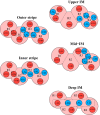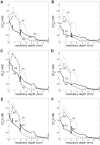Impacts of nitric oxide and superoxide on renal medullary oxygen transport and urine concentration
- PMID: 25651567
- PMCID: PMC4420989
- DOI: 10.1152/ajprenal.00600.2014
Impacts of nitric oxide and superoxide on renal medullary oxygen transport and urine concentration
Abstract
The goal of this study was to investigate the reciprocal interactions among oxygen (O2), nitric oxide (NO), and superoxide (O2 (-)) and their effects on medullary oxygenation and urinary output. To accomplish that goal, we developed a detailed mathematical model of solute transport in the renal medulla of the rat kidney. The model represents the radial organization of the renal tubules and vessels, which centers around the vascular bundles in the outer medulla and around clusters of collecting ducts in the inner medulla. Model simulations yield significant radial gradients in interstitial fluid oxygen tension (Po2) and NO and O2 (-) concentration in the OM and upper IM. In the deep inner medulla, interstitial fluid concentrations become much more homogeneous, as the radial organization of tubules and vessels is not distinguishable. The model further predicts that due to the nonlinear interactions among O2, NO, and O2 (-), the effects of NO and O2 (-) on sodium transport, osmolality, and medullary oxygenation cannot be gleaned by considering each solute's effect in isolation. An additional simulation suggests that a sufficiently large reduction in tubular transport efficiency may be the key contributing factor, more so than oxidative stress alone, to hypertension-induced medullary hypoxia. Moreover, model predictions suggest that urine Po2 could serve as a biomarker for medullary hypoxia and a predictor of the risk for hospital-acquired acute kidney injury.
Keywords: hypoxia; mathematical model; oxygen; sodium transport.
Copyright © 2015 the American Physiological Society.
Figures








References
-
- Bagnasco S, Good D, Balaban R, Burg M. Lactate production in isolated segments of the rat nephron. Am J Physiol Renal Fluid Electrolyte Physiol 248: F522–F526, 1985. - PubMed
-
- Bjornsson TD. Use of serum creatinine concentrations to determine renal function. Clin Pharmacokinet 4: 200–222, 1979. - PubMed
-
- Buerk D, Lamkin-Kennard K, Jaron D. Modeling the influence of superoxide dismutase on superoxide and nitric oxide interactions, including reversible inhibition of oxygen consumption. Free Radic Biol Med 34: 1488–1503, 2003. - PubMed
-
- Chen Y, Gill PS, Welch WJ. Oxygen availability limits renal NADPH-dependent superoxide production. Am J Physiol Renal Physiol 289: F749–F753, 2005. - PubMed
Publication types
MeSH terms
Substances
Grants and funding
LinkOut - more resources
Full Text Sources
Other Literature Sources
Molecular Biology Databases

